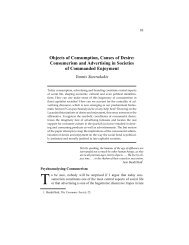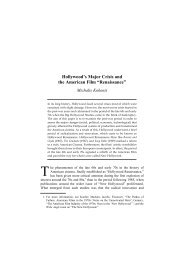19 International Symposium on Theoretical and Applied Linguistics ...
19 International Symposium on Theoretical and Applied Linguistics ...
19 International Symposium on Theoretical and Applied Linguistics ...
Create successful ePaper yourself
Turn your PDF publications into a flip-book with our unique Google optimized e-Paper software.
G E N E R A L S E S S I O N<br />
“Sketch Engine” <strong>and</strong> the “Hellenic Nati<strong>on</strong>al Corpus” are used for English <strong>and</strong> Modern Greek<br />
respectively. Parts of the database entries will be selected to exemplify the templates <strong>and</strong> briefly<br />
present (a) the motivated <strong>and</strong> systematic treatment of polysemy <strong>and</strong> phraseology, <strong>and</strong> (b) the unified<br />
way of comparing <strong>and</strong> c<strong>on</strong>trasting distributi<strong>on</strong>s of semantic c<strong>on</strong>cepts am<strong>on</strong>g different lexical units.<br />
The implicati<strong>on</strong> of the study is that the c<strong>on</strong>structed databases <strong>and</strong> their methodological design can<br />
serve as a model for the development of an extended bilingual lexical resource for the language pair<br />
English – Greek to be used (<strong>and</strong> re-used) by lexicographers writing various types of dicti<strong>on</strong>aries.<br />
References<br />
Atkins, B. T. S. 2002. Bilingual dicti<strong>on</strong>aries: Present, past <strong>and</strong> future. In M.-H. Corréard (ed.), Lexicography <strong>and</strong><br />
Natural Language Processing. A Festschrift in H<strong>on</strong>our of B. S. T. Atkins. Euralex 2002, 1-28.<br />
Atkins, B. T. S. & Rundell, M. 2008. The Oxford Guide to Practical Lexicography. Oxford: Oxford University Press.<br />
British Nati<strong>on</strong>al Corpus (BNC). 2008. (last access: 29-10-2008)<br />
Fillmore, Ch. <str<strong>on</strong>g>19</str<strong>on</strong>g>85. Frames <strong>and</strong> the semantics of underst<strong>and</strong>ing. Quaderni di Semantica 6.2: 222-254.<br />
Fillmore, Ch. & Atkins, B. T. S. <str<strong>on</strong>g>19</str<strong>on</strong>g>92. Toward a frame-based lexic<strong>on</strong>: The semantics of RISK <strong>and</strong> its neighbors. In<br />
A. Lehrer & E. F. Kittay (eds.), Frames, Fields, <strong>and</strong> C<strong>on</strong>trasts. Hillsdale, New Jersey: Lawrence Erlbaum<br />
Associates, 75-102.<br />
Firth, J. R. <str<strong>on</strong>g>19</str<strong>on</strong>g>57. Papers in <strong>Linguistics</strong> <str<strong>on</strong>g>19</str<strong>on</strong>g>34-<str<strong>on</strong>g>19</str<strong>on</strong>g>51. Oxford: Oxford University Press.<br />
Hellenic Nati<strong>on</strong>al Corpus (HNC). 2008. (last access: 29-10-2008)<br />
Lakoff, G. & Johns<strong>on</strong>, M. <str<strong>on</strong>g>19</str<strong>on</strong>g>80. Metaphors We Live By. Chicago <strong>and</strong> L<strong>on</strong>d<strong>on</strong>: The University of Chicago Press.<br />
Sinclair, J. <str<strong>on</strong>g>19</str<strong>on</strong>g>91. Corpus, C<strong>on</strong>cordance, Collocati<strong>on</strong>. Oxford: Oxford University Press.<br />
Sinclair, J. 2003. Reading C<strong>on</strong>cordances. An Introducti<strong>on</strong>. L<strong>on</strong>d<strong>on</strong>: Pears<strong>on</strong> Educati<strong>on</strong> Limited.<br />
Pragmatic factors that determine main clause c<strong>on</strong>stituent order variati<strong>on</strong> in Greek<br />
Efrosini Deligianni<br />
University of Lancaster<br />
e.deligianni@lancaster.ac.uk, efrodelig@yahoo.co.uk<br />
A recurring comm<strong>on</strong>place in descripti<strong>on</strong>s of Greek word order is that all six logically possible<br />
permutati<strong>on</strong>s of the major clausal c<strong>on</strong>stituents [S V O] yield grammatical linearizati<strong>on</strong> patterns. This<br />
general observati<strong>on</strong> seems to hold true for all historical stages of the language.<br />
N<strong>on</strong>etheless, there are two major arguments that point towards word order reorganizati<strong>on</strong> in Greek.<br />
First, Taylor (<str<strong>on</strong>g>19</str<strong>on</strong>g>94), Horrocks (<str<strong>on</strong>g>19</str<strong>on</strong>g>97: 59-60) <strong>and</strong> Atchis<strong>on</strong> (2001: 162-64 & <str<strong>on</strong>g>19</str<strong>on</strong>g>5-96) am<strong>on</strong>g others<br />
have put forth the claim that word order change of the OV→VO type is attested in the history of Greek,<br />
which moves toward completi<strong>on</strong> in the Hellenistic era. Furthermore, Dover (<str<strong>on</strong>g>19</str<strong>on</strong>g>60:10ft, 68) arrived at<br />
the c<strong>on</strong>clusi<strong>on</strong>, although tentative, that syntactic determinants of word order have emerged in<br />
Hellenistic Greek, which were irrelevant in Ancient Greek (AG). Sec<strong>on</strong>d, the prep<strong>on</strong>derance of SVO in<br />
main declarative clauses is uniformly agreed by all researchers in the field. Most importantly,<br />
Georgakopoulos et al. (2006), in collaborati<strong>on</strong> with the research project D2 <strong>on</strong> Typology of Informati<strong>on</strong><br />
Structure set out to empirically assess the claim that “…c<strong>on</strong>temporary Modern Greek (MG) shifts<br />
towards a language type with rigid SVO word order, allowing for alternative word orders <strong>on</strong>ly to<br />
express topicalizati<strong>on</strong> or focus <strong>on</strong> a c<strong>on</strong>stituent”. Based <strong>on</strong> the above, this study asserts that there is a<br />
move towards syntacticizati<strong>on</strong> in MG. This can be empirically verified if an unmarked word order can<br />
be clearly identified, which is used in a variety of pragmatic c<strong>on</strong>texts. C<strong>on</strong>currently, all the alternative<br />
orderings are reserved for specialized pragmatic functi<strong>on</strong>s.<br />
Greek is specially well-suited for diachr<strong>on</strong>ic study, due its l<strong>on</strong>g written history (8 th c. AD. <strong>on</strong>wards).<br />
It is this c<strong>on</strong>tinuous attestati<strong>on</strong> which has rendered possible the compilati<strong>on</strong> of a broadly<br />
representative corpus of historical narrative texts. It is comprised of text extracts of 300 clauses from<br />
five representative texts per historical period. Data analysis is placed within Knud Lambrecht’s<br />
informati<strong>on</strong> structure (IS) theoretical framework (<str<strong>on</strong>g>19</str<strong>on</strong>g>86, <str<strong>on</strong>g>19</str<strong>on</strong>g>87, <str<strong>on</strong>g>19</str<strong>on</strong>g>94, 2000), as it is the most elaborate<br />
<strong>on</strong>e to date. Lambrecht’s analysis generates a tax<strong>on</strong>omy of declarative IS types. Their<br />
interrelati<strong>on</strong>ships have also been laid out explicitly by means of a circular representati<strong>on</strong> in c<strong>on</strong>ceptual<br />
space. The interacti<strong>on</strong> of three interrelated parameters was investigated: functi<strong>on</strong>al structure, which<br />
describes the actual order of elements in the clause (i.e. S-V-O), syntactic structure, <strong>and</strong> informati<strong>on</strong><br />
structure.<br />
The research hypothesis has been fully substantiated by data analysis. In AG, <strong>on</strong> the <strong>on</strong>e h<strong>and</strong>, it<br />
is not possible to identify a single word order pattern as the unmarked <strong>on</strong>e. SV(O) is restricted to<br />
shifted topic-comment clauses, a topic-comment subcategory. Besides, there is no direct mapping<br />
between syntactic c<strong>on</strong>structi<strong>on</strong>s <strong>and</strong> pragmatic c<strong>on</strong>texts. In MG, <strong>on</strong> the other h<strong>and</strong>, SV(O) has been<br />
‘promoted’ to the status of the unmarked word order type. This is typically linked to topic-comment<br />
<str<strong>on</strong>g>19</str<strong>on</strong>g> th ISTAL 11






